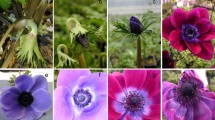Summary
In incompatible (intramorph) pollinations of the heterostylousPrimula vulgaris, pollen germination or tube growth may be partially inhibited in several sites associated with the stigma or style. Blockage may occur, a) on the stigma surface through the failure of germination or of pollen tube penetration after germination, b) in the stigma head during the passage of the tube through the specialized transmitting tissue of the head, or c) in the transmitting tract of the style. None of the barriers is complete, and the prohibition of selfing or intramorph crossing depends upon the cumulative screening effect of one following upon the other. In both morphs, the germination of incompatible pollen on the stigma is enhanced in high ambient relative humidity, but many tubes still fail to penetrate the stigma. Those that do are retarded or blocked in their growth in the transmitting tissues of the stigma head and style. Crude extracts from the tissues of the stigma head and style show some differential effect on the growth of pollen tubesin vitro, and dialysates of extracts containing high molecular weight fractions show a consistent differential effect, those from thrum tissues retarding thrum tubes while having a lesser effect on pin tubes, and those from pin tissues retarding pin tubes while having lesser effect on thrum. It is suggested that the factors influencing tube growth are present in the intercellular secretions of the transmitting tract.
Similar content being viewed by others
References
Darwin, C., 1862: On the two forms, or dimorphic condition, in the species ofPrimula, and on their remarkable sexual relations. Proc. Linn. Soc. (Bot.)6, 105–139.
—, 1877: The different forms of flowers on plants of the same species. London: John Murray.
Dulberger, R., 1974: Structural dimorphism of stigmatic papillae in distylousLinum species. Amer. J. Bot.61, 238–243.
Ferrari, T. E., Wallace, D. H., 1975: Germination ofBrassica pollen and expression of incompatibilityin vitro. Euphytica24, 757–765.
Golinskaya, E. L., Bashnikova, N. V., Tomchuk, N. N., 1976: Phytohaemagglutinins of the pistil inPrimula as possible proteins of generative incompatibility. Sov. Plant Phys.23, 169–176 (translated from Fiziol. Rasteni23, 88–97).
Heslop-Harrison, J., 1975: The physiology of the pollen grain surface. Proc. Roy. Soc. London.B 190, 275–299.
—, 1979: An interpretation of the hydrodynamics of pollen. Amer. J. Bot.66, 737–743.
—,Heslop-Harrison, Y., 1970: Evaluation of pollen viability by enzymically induced fluorescence: intracellular hydrolysis of fluorescein diacetate. Stain Technol.45, 115–120.
- - 1979: Pollen stigma interaction in other families. Rep. Welsh Plant Breeding Stn. for 1978, 149–151.
— —,Knox, R. B., Howlett, B., 1973: Pollen-wall proteins: “gametophytic” and “sporophytic” fractions in the walls of theMalvaceae. Ann. Bot.37, 403–412.
— —,Shivanna, K. R., 1981: Heterostyly inPrimula. 1. Fine structural and cytochemical features of the stigma and style inPrimula vulgaris Huds. Protoplasma107, 171–187.
Linskens, H. F., Esser, K., 1957: Über eine spezifische Anfärbung der Pollenschläuche — die Zahl der Kailosepfropfen nach Selbstung und Fremdung. Naturwiss.44, 16.
Nowicke, J., Skvarla, J. J., 1977: Pollen morphology and the relationships of thePlumbaginaceae, Polygonaceae, andPrimulaceae to the orderCentrospermae. Smithsonian Contribut. to Botany No.37, 1–64.
Ornduff, R., 1979: Pollen flow in a population ofPrimula vulgaris Huds. Bot. J. Linn. Soc.78, 1–10.
Ruchel, R., 1976: Sequential protein analysis from single identified neurons ofAplysia californica. A microelectrophoretic technique involving polyacrylamide gradient gels and isoelectric focusing. J. Histochem. Cytochem.24, 773–791.
Shivanna, K. R.,Heslop-Harrison, J., 1981: Membrane state and pollen viability. Ann. Bot. (in press).
Weast, R. C., 1980: CRC handbook of chemistry and physics. Florida, CRC Press.
Author information
Authors and Affiliations
Rights and permissions
About this article
Cite this article
Shivanna, K.R., Heslop-Harrison, J. & Heslop-Harrison, Y. Heterostyly inPrimula. 2. Sites of pollen inhibition, and effects of pistil constituents on compatible and incompatible pollen-tube growth. Protoplasma 107, 319–337 (1981). https://doi.org/10.1007/BF01276833
Received:
Accepted:
Issue Date:
DOI: https://doi.org/10.1007/BF01276833




